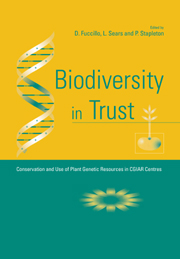Book contents
- Frontmatter
- Contents
- Preface
- Contributors
- Acronyms
- Chapter 1 Cassava
- Chapter 2 The Potato
- Chapter 3 Sweetpotato
- Chapter 4 Other Andean Roots and Tubers
- Chapter 5 Yams
- Chapter 6 Banana and Plantain
- Chapter 7 Cowpea
- Chapter 8 Chickpea
- Chapter 9 Groundnut
- Chapter 10 Lentil
- Chapter 11 Phaseolus Beans
- Chapter 12 Pigeonpea
- Chapter 13 Faba Bean
- Chapter 14 Soyabean
- Chapter 15 Barley
- Chapter 16 Maize, Tripsacum and Teosinte
- Chapter 17 Pearl Millet
- Chapter 18 Small Millets
- Chapter 19 Rice
- Chapter 20 Sorghum
- Chapter 21 Wheat
- Chapter 22 Forages
- Index
Chapter 21 - Wheat
Published online by Cambridge University Press: 22 September 2009
- Frontmatter
- Contents
- Preface
- Contributors
- Acronyms
- Chapter 1 Cassava
- Chapter 2 The Potato
- Chapter 3 Sweetpotato
- Chapter 4 Other Andean Roots and Tubers
- Chapter 5 Yams
- Chapter 6 Banana and Plantain
- Chapter 7 Cowpea
- Chapter 8 Chickpea
- Chapter 9 Groundnut
- Chapter 10 Lentil
- Chapter 11 Phaseolus Beans
- Chapter 12 Pigeonpea
- Chapter 13 Faba Bean
- Chapter 14 Soyabean
- Chapter 15 Barley
- Chapter 16 Maize, Tripsacum and Teosinte
- Chapter 17 Pearl Millet
- Chapter 18 Small Millets
- Chapter 19 Rice
- Chapter 20 Sorghum
- Chapter 21 Wheat
- Chapter 22 Forages
- Index
Summary
Wheat is grown in almost all cropping environments of the world, except in the humid lowland tropics. Winter wheat under rain-fed conditions dominates in Europe, the USA, Ukraine and southern Russia, followed by spring-sown spring wheat in semi-arid conditions (Canada, Kazhakstan and Siberia) in the developed world. In the developing world, wheat is usually not a subsistence crop and its production is concentrated in several well-defined cropping systems: double-cropped with paddy rice in Asia (22 million ha) or with maize, cotton, soybean or berseem (15 million ha); with soybean in the Southern Cone (7 million ha). Only in the wetter parts of the developed world, such as the eastern USA, Europe and southern Russia, and in parts of the Southern Cone, is wheat grown in more complex rotational systems involving pulses, oilseeds, other cereals, alfalfa and pastures. An exception is southern Australia, where, despite low rainfall, complex rotations and ley farming are practised.
BOTANY AND DISTRIBUTION
Origin, Distribution and Diffusion
Wheat belongs to the genus Triticum, which originated about 10 000 years ago in what is now the Middle East. Polyploid Triticum arose when two diploid wild grasses crossed naturally to produce tetraploid wheat, which today includes cultivated durum wheat (Triticum turgidum L. var. group durum Desf. 2n=4x=28). Tetraploid wheat later outcrossed to goat grass (T. tauschii, considered a troublesome weed in many wheat-growing areas) and gave rise to hexaploid bread wheat (T. aestivum L. em Thel. 2n=6x=42).
- Type
- Chapter
- Information
- Biodiversity in TrustConservation and Use of Plant Genetic Resources in CGIAR Centres, pp. 309 - 320Publisher: Cambridge University PressPrint publication year: 1997

